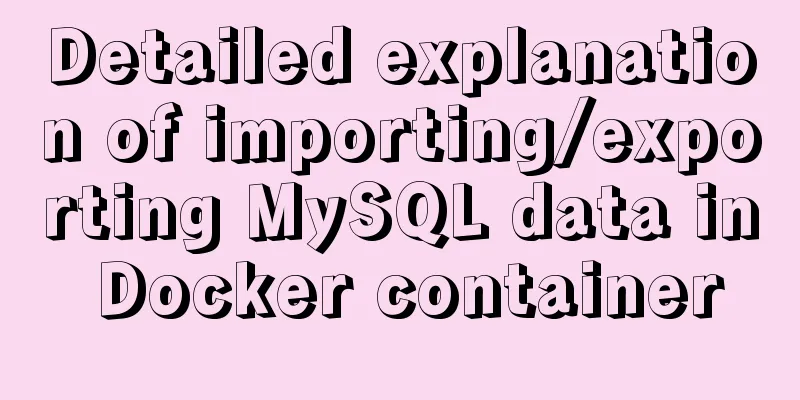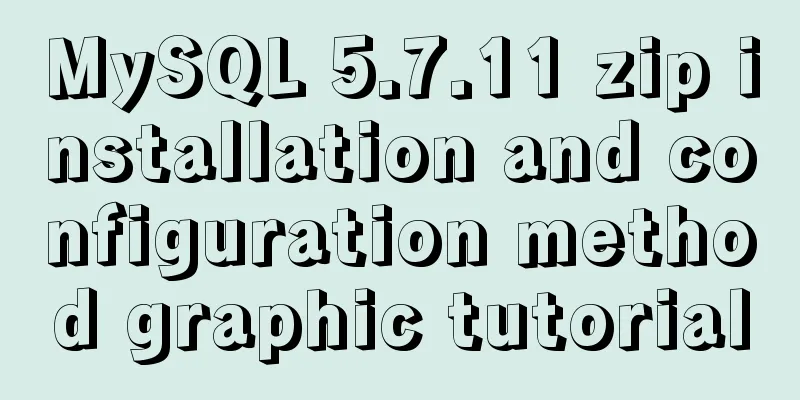Detailed explanation of importing/exporting MySQL data in Docker container

|
Preface We all know that the import and export of MySQL data can be solved with a mysqldump command, but what if MySQL is running in a docker environment? The solution is to use the mysqldump command, but we need to enter the mysql container of docker to execute it, and configure volumes so that the exported data files can be copied to the host machine's disk. So the operation steps can be divided into:
As for data import, it is too simple to explain. Let's first look at the common options of the mysqldump command:
Configuring volumes First, I use docker-compose to arrange the docker containers. For the complete configuration code, please see this project: liumapp/rabbitmq-mysql-redis-in-docker Please note the following lines in the docker-compose.yml configuration file of this project: mysql: container_name: mysql image:mysql:5.5.60 restart: always volumes: - ./mysql/data:/var/lib/mysql - ./mysql/conf/mysqld.conf:/etc/mysql/mysql.conf.d/mysqld.cnf The volumes I configured for the mysql container are to map the project's mysql/data directory to the /var/lib/mysql in the docker container. So when I enter the mysql container of docker and execute the export command, I only need to export the data in the /var/lib/mysql/ directory, and I can find the corresponding data file in the ./mysql/data/ directory of the host machine. Enter the container to export data First execute docker ps Find the name of the mysql container Then execute docker exec -it mysql /bin/bash Entering the container Execute Command whereis mysql Find the running path of mysql, here is: /usr/local/mysql/bin, enter it with cd cd /usr/local/mysql/bin Please note that the path here refers to the path inside the Docker container and has nothing to do with your host path. Execute the export command mysqldump -u username -p database name> save file .sql After entering the password, the export is basically successful. Please note that the path to save the file should be set under volumes, that is, /var/lib/mysql/ Then enter exit Exit the container and return to the host machine, we can find the exported data file If you want to export in csv format, change the mysqldump command to: mysql -u username --password=password --database=database name --execute='SELECT `FIELD`, `FIELD` FROM `TABLE` LIMIT 0, 10000 ' -X > Save file.sql You can Summarize The above is the full content of this article. I hope that the content of this article will have certain reference learning value for your study or work. If you have any questions, you can leave a message to communicate. Thank you for your support for 123WORDPRESS.COM. You may also be interested in:
|
<<: jQuery realizes the shuttle box effect
>>: MySQL 5.7.17 installation and configuration tutorial for Mac
Recommend
Simple tutorial on using Navicat For MySQL
recommend: Navicat for MySQL 15 Registration and ...
Create an SSL certificate that can be used in nginx and IIS
Table of contents Creating an SSL Certificate 1. ...
Detailed explanation of :key in VUE v-for
When key is not added to the v-for tag. <!DOCT...
Detailed explanation of top command output in Linux
Preface I believe everyone has used the top comma...
Automatic backup of MySQL database using shell script
Automatic backup of MySQL database using shell sc...
A brief discussion on several situations where MySQL returns Boolean types
mysql returns Boolean type In the first case, ret...
The Chinese garbled characters in HTML files and the display problems in browsers
My page today also had garbled characters, so I s...
Detailed steps for implementing timeout status monitoring in Apache FlinkCEP
CEP - Complex Event Processing. The payment has n...
Basic operations of MySQL data tables: table structure operations, field operation example analysis
This article uses examples to describe the basic ...
XHTML Tutorial: XHTML Basics for Beginners
<br />This site’s original content, please i...
A brief analysis of the difference between and and where in MySQL connection query
1. Create a table CREATE TABLE `student` ( `id` i...
Analysis of two usages of the a tag in HTML post request
Two examples of the use of the a tag in HTML post...
Complete steps to install FFmpeg in CentOS server
Preface The server system environment is: CentOS ...
Specific use of Linux man command
01. Command Overview Linux provides a rich help m...
7 cool dynamic website designs for inspiration
In the field of design, there are different desig...









